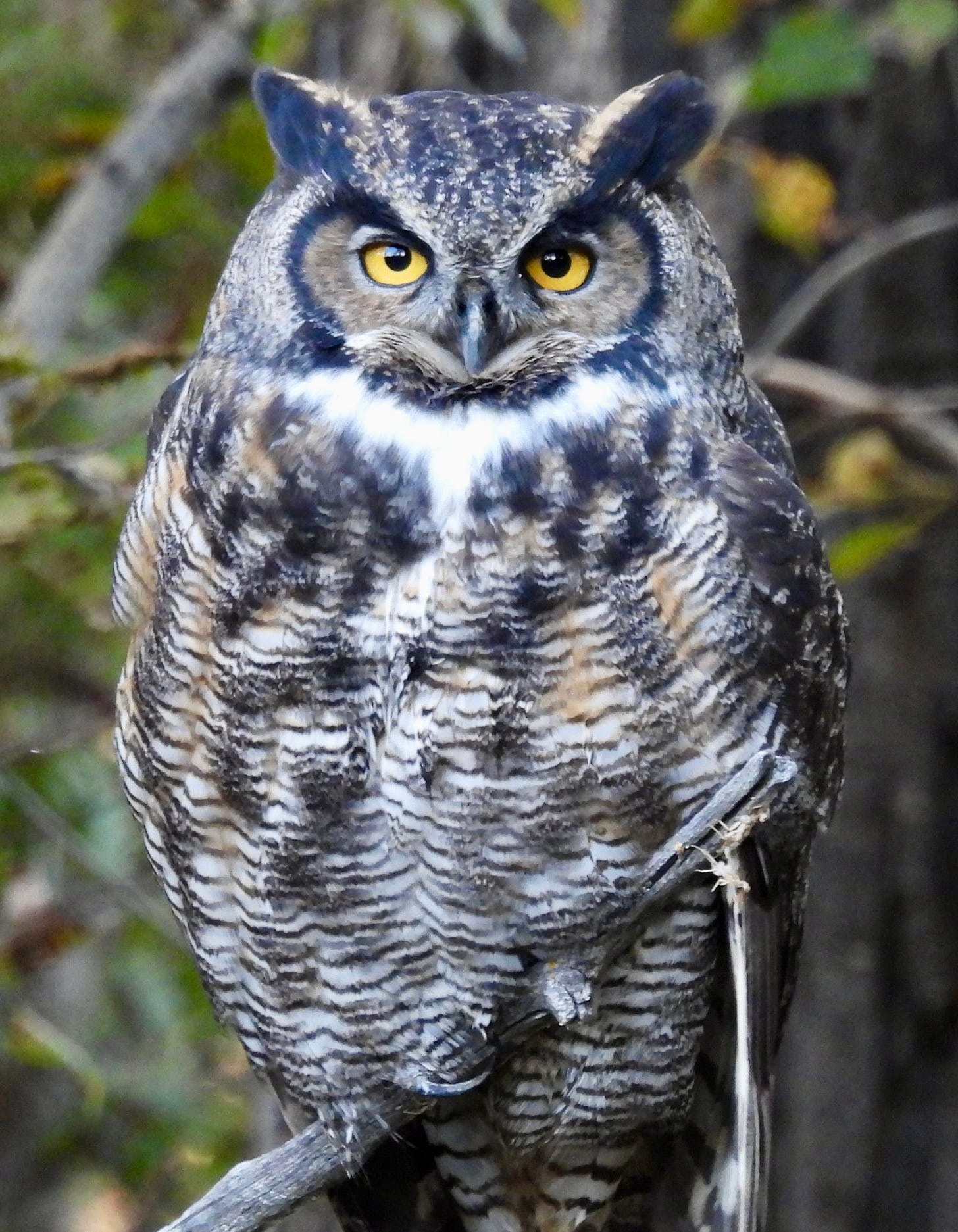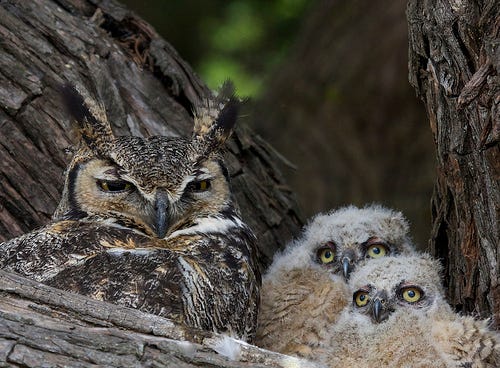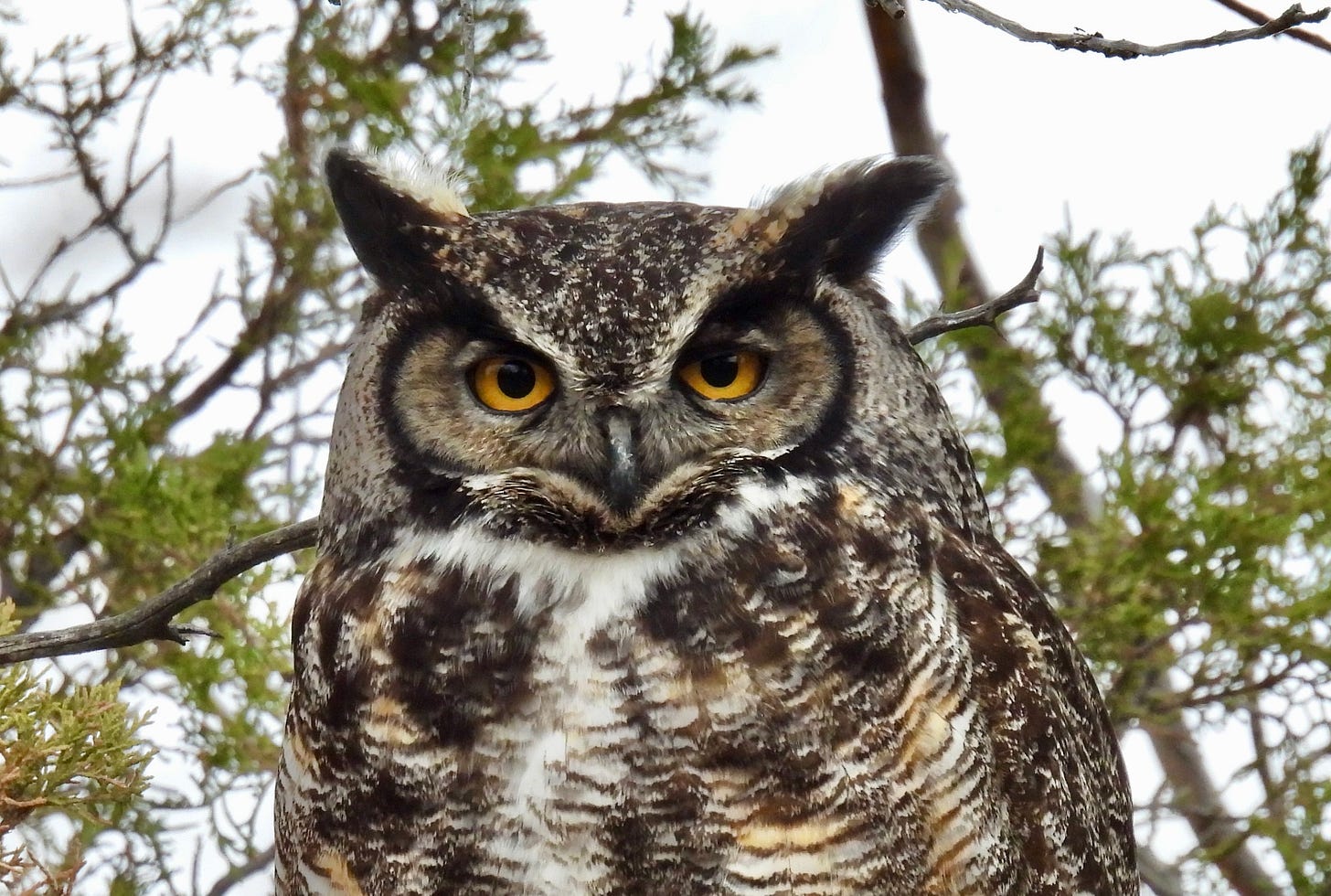
The light to come
January 1, 2025. Hours before dawn, I walked outside into the enveloping darkness. Snow lay softly on a quiet landscape of sagebrush, scattered ponderosa pines, and the wildness of distant mountains. I closed my eyes and hoped, listening intently. Moments later, I heard it: Who’s awake? Me tooooo!
The male Great Horned Owl hooted its signature call from a drainage near my house, claiming last year’s Red-tailed Hawk nest. Great Horned Owls don’t build their own nests. Instead, they co-opt nests built by hawks and other birds or lay their one to four eggs in broken-topped snags, abandoned buildings, or on cliff ledges. Nearly immediately, the female called a higher-pitched response—Who’s awake? Me toooo—and the pair duetted back and forth.
My first bird of 2025. Many bird lovers take note of the first bird they see or hear in the New Year. For some, that bird sets the tone for the year to come. I’d left little to chance this year, wanting my first bird to be special (no destructive non-native House Sparrows for me!) and I knew that I had a good chance of hearing my local Great Horned Owls if I spent enough time outside before daybreak. Great Horned Owls are among the earliest nesting birds in much of the country. In my Montana neighborhood, they begin establishing their territories in December or early January and typically begin egg-laying sometime between late-January and early March.
Each January, I spend time outside in the dark, relishing—and celebrating—hooting Great Horned Owls. Because their calls mark the beginning of the forthcoming bird breeding season, they are my first sign of spring, despite the wintery landscape. In my area, the owls nest first, followed by the raucous Clark’s Nutcrackers. And before too long, my dawn’s will once again be filled with the liquid songs of newly returned meadowlarks, the soft phew of Mountain Bluebirds, and the clear, mournful whistle of Say’s Phoebes. For me, those owls herald the color, the light, the life to come.
As I stood listening to them before dawn on New Year’s day, a series of images filled my mind. An early-nesting Great Horned Owl that placidly incubated her eggs low in a tree nest, mere feet from the entrance to the Missoula airport as I drove past one late-December, long ago. A pair of owls and their downy nestlings in the broken-topped snag that I checked each year in my local wildlife refuge. The Great Horneds that roosted in large willows beside a restaurant I frequented while working in Montana’s beautiful Mission Valley.
I remembered walking a friend’s dogs on a dimly lit university campus. Her cat had appeared out of nowhere, accompanying us on our night walk. Suddenly, a breath of air over my shoulder as a Great Horned Owl swooped at the feckless cat. I lurched forward, waving my arms, and the owl swerved away and landed in a nearby tree, eyeing its feline prey. Grabbing the cat, I rushed the squirming animal back to its home. I wouldn’t risk letting it outside again while caring for my friend’s pets.
I remembered, too, driving with my sister half a mile from my house early last May. “Stop,” she exclaimed suddenly, “I think there’s an owl caught in that fence.” We crossed into a neighboring field and looked in sorrow at one of my local Great Horned Owls—one that I’d regularly observed on my evening walks in the previous few months. One of its desiccated wings was hopelessly tangled in the barbed wire fence, the bird’s body snapped away by coyotes as it hung helplessly one spring night. Wire fences—all too often invisible to distracted birds—ensnare or fatally injure large numbers of them. The image of that owl haunted me, though summer nights filled with the screeching of its young as they food-begged from the parent that had continued to care for them on its own provided some consolation.
Standing in the dark at the dawn of a new year, I listened to the expected—the hoped for hooting. And then I heard the unexpected—another pair of Great Horned Owls calling faintly to the West. I’d have two pairs of Great Horneds to listen to this year! The owls had carved up the landscape into separate territories, their boundaries as unknown to us as our human ownership boundaries were to them.
Winter can be a dark and difficult time. Sometimes life can be, too. Many of us are struggling right now. As I listened to the resonant calls of nocturnal owls, I thought of French writer Albert Camus’s words, “In the depth of winter, I finally learned that within me there lay an invincible summer.” Those hooting owls were a hint to me of the summer within and the summer to come. The brighter bird-filled days that lie ahead. May Great Horned Owls portend the same for all of you.
Take a small step to help birds
It’s easy to feel helpless in the face of habitat destruction and disappearing wildlife. But according to the US Fish and Wildlife Service, over 96 million people in North America watch birds. If each of us does something to help them, we may be able to reverse declining bird numbers.
Nocturnal wildlife thrives in darkness. Keeping outdoor lighting to a minimum and turning off unnecessary lights in your homes allows wildlife to carry on with its activities with minimal interference and disruption.
Avoid using rodenticides around your homes since owls and other raptors may be killed if they capture poisoned rodents.
Great Horned Owls are masterful predators that have a more diverse diet than any other North American bird of prey. Their menu includes domestic cats! So keep your cat safe by keeping it indoors (your local birds will benefit, too).
Fence visibility markers—small plastic tags that make fences more visible to wildlife—can drastically reduce bird collisions. This year, I plan to purchase fence markers and ask the rancher who owns the field where I found the snared owl if I can mark his fence. I also hope to install markers on a fenceline that runs through one of my forested hikes since it poses a threat to accipiters—bird-hunting forest hawks—and the birds they are pursuing.
Until next time …
P.S. Please help me spread my conservation messages about birds by asking your local library or bookstore if they have my book Feather Trails—A Journey of Discovery Among Endangered Birds.






Thank you. Your words bring me a little hope for the future during a time that is dark indeed. And maybe we can all agree on the need to protect our precious and miraculous environment and the natural creatures in it, even when we can't seem to agree on much else. I have your book and I am excited to read it!
Once again, Sophie, such a wonderful post! In Wyoming, where winters can seem unbearably long, my first observation of nesting great horned owls or golden eagles heralds the advent of spring, regardless of the weather and the fact that we may get snow, even occasionally, into June. And, like you, I await my first bird of the year with eager anticipation tempered by the determination that I will close my eyes and look away from any place where I'm likely to see a starling, house sparrow, rock pigeon, or Eurasian collared dove before I see a "proper" native bird. Thank you also for spreading the word about the dangers of fences to wildlife. I, too, have seen gut-wrenching instances of owls, hawks, sage-grouse (one instance of 20+ individuals at a single location), deer, pronghorn, and elk entangled in barbed wire. Sheep-tight fence is also deadly for entanglement. I was fortunate to be able to rescue a newborn pronghorn fawn from sheep-tight fence in time to avoid the injury of the fawn and the abandonment of the doe...a very happy ending to what would otherwise have been a heartbreaking outcome!